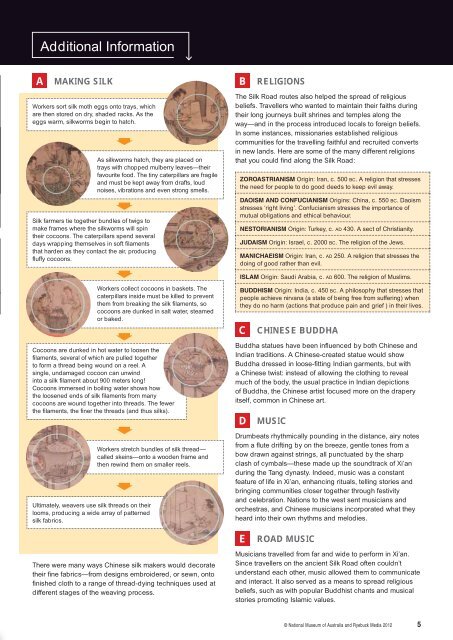Silk Road â unit of work - National Museum of Australia
Silk Road â unit of work - National Museum of Australia
Silk Road â unit of work - National Museum of Australia
Create successful ePaper yourself
Turn your PDF publications into a flip-book with our unique Google optimized e-Paper software.
Additional InformationAMAKING SILKWorkers sort silk moth eggs onto trays, whichare then stored on dry, shaded racks. As theeggs warm, silkworms begin to hatch.As silkworms hatch, they are placed ontrays with chopped mulberry leaves—theirfavourite food. The tiny caterpillars are fragileand must be kept away from drafts, loudnoises, vibrations and even strong smells.<strong>Silk</strong> farmers tie together bundles <strong>of</strong> twigs tomake frames where the silkworms will spintheir cocoons. The caterpillars spend severaldays wrapping themselves in s<strong>of</strong>t fi lamentsthat harden as they contact the air, producingfl uffy cocoons.BRELIGIONSThe <strong>Silk</strong> <strong>Road</strong> routes also helped the spread <strong>of</strong> religiousbeliefs. Travellers who wanted to maintain their faiths duringtheir long journeys built shrines and temples along theway—and in the process introduced locals to foreign beliefs.In some instances, missionaries established religiouscomm<strong>unit</strong>ies for the travelling faithful and recruited convertsin new lands. Here are some <strong>of</strong> the many different religionsthat you could fi nd along the <strong>Silk</strong> <strong>Road</strong>:ZOROASTRIANISM Origin: Iran, c. 500 BC. A religion that stressesthe need for people to do good deeds to keep evil away.DAOISM AND CONFUCIANISM Origins: China, c. 550 BC. Daoismstresses ‘right living’. Confucianism stresses the importance <strong>of</strong>mutual obligations and ethical behaviour.NESTORIANISM Origin: Turkey, c. AD 430. A sect <strong>of</strong> Christianity.JUDAISM Origin: Israel, c. 2000 BC. The religion <strong>of</strong> the Jews.MANICHAEISM Origin: Iran, c. AD 250. A religion that stresses thedoing <strong>of</strong> good rather than evil.ISLAM Origin: Saudi Arabia, c. AD 600. The religion <strong>of</strong> Muslims.Workers collect cocoons in baskets. Thecaterpillars inside must be killed to preventthem from breaking the silk fi laments, sococoons are dunked in salt water, steamedor baked.Cocoons are dunked in hot water to loosen thefi laments, several <strong>of</strong> which are pulled togetherto form a thread being wound on a reel. Asingle, undamaged cocoon can unwindinto a silk fi lament about 900 meters long!Cocoons immersed in boiling water shows howthe loosened ends <strong>of</strong> silk fi laments from manycocoons are wound together into threads. The fewerthe fi laments, the fi ner the threads (and thus silks).Ultimately, weavers use silk threads on theirlooms, producing a wide array <strong>of</strong> patternedsilk fabrics.Workers stretch bundles <strong>of</strong> silk thread—called skeins—onto a wooden frame andthen rewind them on smaller reels.There were many ways Chinese silk makers would decoratetheir fi ne fabrics—from designs embroidered, or sewn, ont<strong>of</strong>i nished cloth to a range <strong>of</strong> thread-dying techniques used atdifferent stages <strong>of</strong> the weaving process.BUDDHISM Origin: India, c. 450 BC. A philosophy that stresses thatpeople achieve nirvana (a state <strong>of</strong> being free from suffering) whenthey do no harm (actions that produce pain and grief ) in their lives.CBuddha statues have been infl uenced by both Chinese andIndian traditions. A Chinese-created statue would showBuddha dressed in loose-fi tting Indian garments, but witha Chinese twist: instead <strong>of</strong> allowing the clothing to revealmuch <strong>of</strong> the body, the usual practice in Indian depictions<strong>of</strong> Buddha, the Chinese artist focused more on the draperyitself, common in Chinese art.DDrumbeats rhythmically pounding in the distance, airy notesfrom a fl ute drifting by on the breeze, gentle tones from abow drawn against strings, all punctuated by the sharpclash <strong>of</strong> cymbals—these made up the soundtrack <strong>of</strong> Xi’anduring the Tang dynasty. Indeed, music was a constantfeature <strong>of</strong> life in Xi’an, enhancing rituals, telling stories andbringing comm<strong>unit</strong>ies closer together through festivityand celebration. Nations to the west sent musicians andorchestras, and Chinese musicians incorporated what theyheard into their own rhythms and melodies.ECHINESE BUDDHAMUSICROAD MUSICMusicians travelled from far and wide to perform in Xi’an.Since travellers on the ancient <strong>Silk</strong> <strong>Road</strong> <strong>of</strong>ten couldn’tunderstand each other, music allowed them to communicateand interact. It also served as a means to spread religiousbeliefs, such as with popular Buddhist chants and musicalstories promoting Islamic values.© <strong>National</strong> <strong>Museum</strong> <strong>of</strong> <strong>Australia</strong> and Ryebuck Media 20125

















